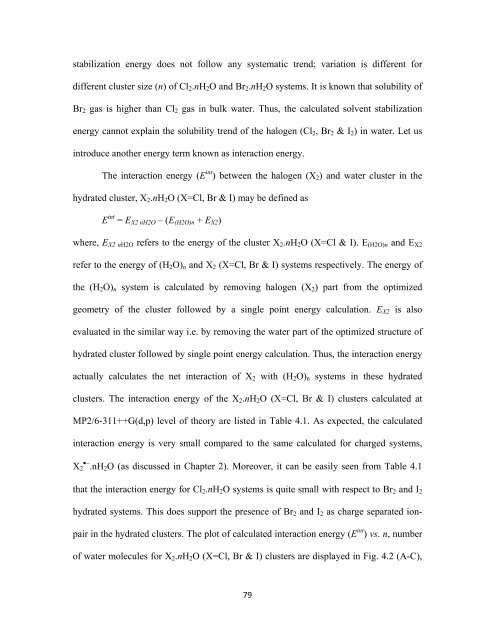CHEM01200604005 A. K. Pathak - Homi Bhabha National Institute
CHEM01200604005 A. K. Pathak - Homi Bhabha National Institute
CHEM01200604005 A. K. Pathak - Homi Bhabha National Institute
Create successful ePaper yourself
Turn your PDF publications into a flip-book with our unique Google optimized e-Paper software.
stabilization energy does not follow any systematic trend; variation is different for<br />
different cluster size (n) of Cl 2 .nH 2 O and Br 2 .nH 2 O systems. It is known that solubility of<br />
Br 2 gas is higher than Cl 2 gas in bulk water. Thus, the calculated solvent stabilization<br />
energy cannot explain the solubility trend of the halogen (Cl 2 , Br 2 & I 2 ) in water. Let us<br />
introduce another energy term known as interaction energy.<br />
The interaction energy (E int ) between the halogen (X 2 ) and water cluster in the<br />
hydrated cluster, X 2 .nH 2 O (X=Cl, Br & I) may be defined as<br />
E int = E X2 nH2O – (E (H2O)n + E X2 )<br />
where, E X2 nH2O refers to the energy of the cluster X 2 .nH 2 O (X=Cl & I). E (H2O)n and E X2<br />
refer to the energy of (H 2 O) n and X 2 (X=Cl, Br & I) systems respectively. The energy of<br />
the (H 2 O) n system is calculated by removing halogen (X 2 ) part from the optimized<br />
geometry of the cluster followed by a single point energy calculation. E X2 is also<br />
evaluated in the similar way i.e. by removing the water part of the optimized structure of<br />
hydrated cluster followed by single point energy calculation. Thus, the interaction energy<br />
actually calculates the net interaction of X 2 with (H 2 O) n systems in these hydrated<br />
clusters. The interaction energy of the X 2 .nH 2 O (X=Cl, Br & I) clusters calculated at<br />
MP2/6-311++G(d,p) level of theory are listed in Table 4.1. As expected, the calculated<br />
interaction energy is very small compared to the same calculated for charged systems,<br />
X •− 2 .nH 2 O (as discussed in Chapter 2). Moreover, it can be easily seen from Table 4.1<br />
that the interaction energy for Cl 2 .nH 2 O systems is quite small with respect to Br 2 and I 2<br />
hydrated systems. This does support the presence of Br 2 and I 2 as charge separated ionpair<br />
in the hydrated clusters. The plot of calculated interaction energy (E int ) vs. n, number<br />
of water molecules for X 2 .nH 2 O (X=Cl, Br & I) clusters are displayed in Fig. 4.2 (A-C),<br />
79
















